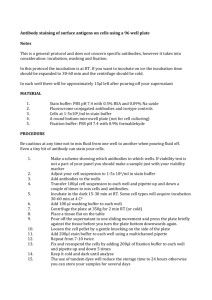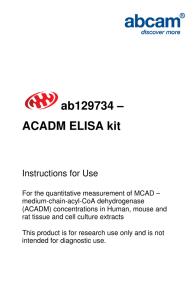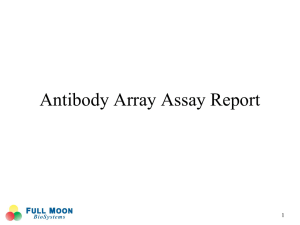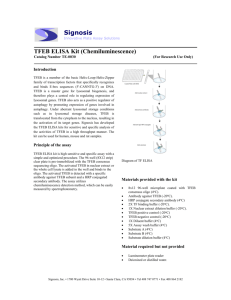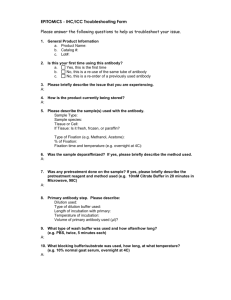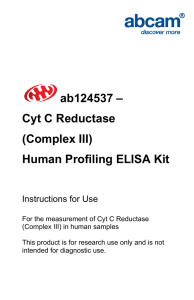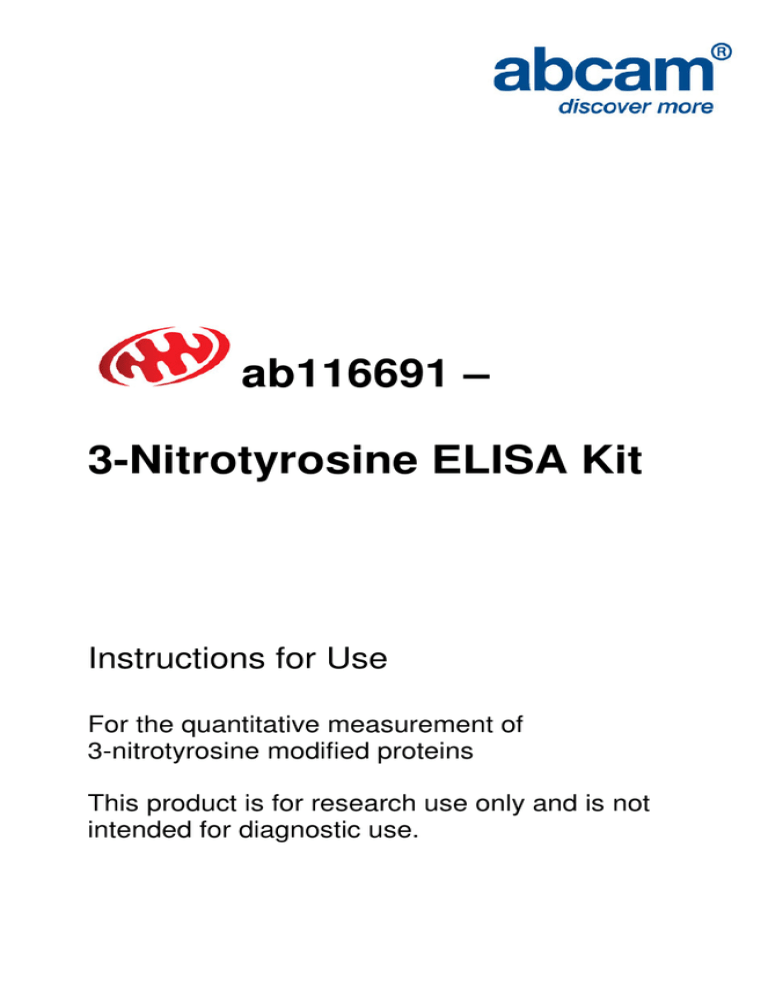
ab116691 –
3-Nitrotyrosine ELISA Kit
Instructions for Use
For the quantitative measurement of
3-nitrotyrosine modified proteins
This product is for research use only and is not
intended for diagnostic use.
1
Table of Contents
1.
Introduction
3
2.
Assay Summary
5
3.
Kit Contents
6
4.
Storage and Handling
6
5.
Additional Materials Required
7
6.
Preparation of Reagents
7
7.
Sample Preparation
9
8.
Assay Procedure
11
9.
Data Analysis
14
10. Specificity
18
11. Troubleshooting
19
2
1. Introduction
Principle:
ab116691
Immunosorbent
Assay)
3-nitrotyrosine
kit
is
an
ELISA
in
vitro
(Enzyme-Linked
enzyme-linked
immunosorbent assay for the quantitative measurement of 3nitrotyrosine in cell and tissue lysates.
The assay employs an
antibody specific for 3-nitrotyrosine coated on a 96-well plate.
Standards and samples are pipetted into the wells and 3nitrotyrosine present in the sample is bound to the wells by the
immobilized antibody. The wells are washed and a biotin labeled
anti-3-nitrotyrosine detector antibody is added. After washing away
unbound detector antibody, HRP-conjugated streptavidin specific for
the biotin labeled detector antibody is pipetted into the wells. The
wells are again washed, an HRP substrate solution (TMB) is added
to the wells and color develops in proportion to the amount of 3nitrotyrosine bound. The developing blue color is measured at 600
nm. Optionally the reaction can be stopped by adding hydrochloric
acid which changes the color from blue to yellow and the intensity
can be measured at 450 nm.
3
Background: 3-nitrotyrosine modification of proteins is a well
established marker of protein damage by oxidative stress.
3-
nitrotyrosine is a product of protein tyrosine nitration resulting from
oxidative damage to proteins by peroxynitrite.
Peroxynitrite is a
formed in vivo by the reaction of nitric oxide, a cellular messenger,
and superoxide, the majority of which is generated by the
mitochondrial respiratory chain.
3-nitrotyrosine modification of
proteins can result in changes in protein structure, function and
catalytic activity. Tyrosine nitration may increase (e.g. sGC, Src,
PI3K, Akt), decrease (e.g. Mn-SOD, Ca++-ATPase), or have no
discernable effect (e.g. p53, VASP, α-Synuclein) on the activity of a
particular protein.
Tyrosine nitration has been implicated in the
pathogenesis of major neurological (Alzheimer's, Parkinson's,
multiple sclerosis, and stroke) and cardiovascular (atherosclerosis,
myocardial
infarction,
coronary
artery
disease,
hypertension)
diseases that share inflammation as a contributor to pathogenesis.
4
2. Assay Summary
Bring all reagents to room temperature. Prepare all the reagents,
samples, and standards as instructed.
Add 50 µL standard or sample to each well used. Incubate 2 hours
at room temperature.
Aspirate and wash each well two times. Add 50 µL prepared
detector antibody to each well. Incubate 1 hour at room
temperature.
Aspirate and wash each well two times. Add 50 µL prepared
HRP label. Incubate 1 hour at room temperature.
Aspirate and wash each well three times. Add 100 µL TMB
Development Solution to each well. Record immediately the
color development with time at 600 nm for 15 minutes.
Alternatively add a Stop solution at a user-defined time and read
at 450 nm.
5
3. Kit Contents
Item
Quantity
20X Buffer
20 mL
Extraction Buffer
15 mL
10X Blocking Buffer
6 mL
TMB Development Solution
12 mL
10X 3-nitrotyrosine Detector Antibody
1 mL
10X HRP Label
1 mL
3-nitrotyrosine BSA standard (4 µg)
1 vial
Microplate 96 antibody coated wells in 12 strips
1
4. Storage and Handling
Store all components at 4°C.
This kit is stable for 6 months from
receipt. After reconstitution the standard should be stored at -80°C.
Unused microplate strips should be returned to the pouch containing
the desiccant and resealed.
6
5. Additional Materials Required
•
Microplate reader capable of measuring absorbance at 600
nm (or 450 nm after addition of Stop solution - not supplied).
•
Method for determining protein concentration (BCA assay
recommended).
•
Deionized water
•
Multi and single channel pipettes
•
PBS (1.4 mM KH2PO4, 8 mM Na2HPO4, 140 mM NaCl, 2.7
mM KCl, pH 7.3)
•
Tubes for standard dilution
•
Stop solution (optional) – 1N hydrochloric acid
•
Optional plate shaker for all incubation steps
6. Preparation of Reagents
1. Bring all reagents and samples to room temperature
o
(18-25 C) before use.
2. Prepare 1X Wash Buffer by adding 20 mL 20X Buffer to
380 mL nanopure water.
7
3. Prepare 1X Incubation Buffer by adding 6 mL 10X Blocking
Buffer to 54 mL 1X Wash Buffer. After performing the ELISA
freeze unused 1X Incubation buffer.
4. Dilute the 3-nitrotyrosine protein detector antibody 10-fold
with 1X Incubation Buffer immediately before use. Prepare
0.5 mL for each strip used.
5. Dilute the HRP label 10-fold with 1X Incubation Buffer
immediately before use. Prepare 0.5 mL for each strip used.
6. Reconstitute the standard with 1 mL 1X Incubation buffer by
pipetting. Allow to sit for 10 minutes and repeat pipetting to
ensure thorough reconstitution.
This 4 µg/mL stock of
standard material is then used to generate a standard curve
in labeled tubes. Add 150 µL of the stock to a tube labeled
#1 dilute Tube #1 further by adding 3 volumes, 450 µL, of 1X
incubation buffer for a final concentration of 1 µg/mL. The
o
remaining stock material can be stored at -80 C.
7. Label tubes #2-7. Add 150 µL of 1X Incubation buffer to
each of #2 through #15.
Transfer 150 µL from 1 µg/mL
Tube #1 to tube #2. Mix thoroughly. With a fresh pipette tip
transfer 150 µL from #2 to #3. Mix thoroughly. Repeat for
Tubes #4 through #7. Use 1X Incubation buffer as the zero
standard. Use a fresh standard for each assay.
8
150 µl
1
1 µg/mL
150 µl
150 µl
150 µl
150 µl
2
3
4
5
1/2
1/4
1/8
1/16
in
1X Incubation buffer
6
1/32
150 µl
7
1/64
Etc.
7. Sample Preparation
Note: Extraction buffer can be supplemented with phosphatase
inhibitors, PMSF and protease inhibitor cocktail prior to use.
Supplements should be used according to manufacturer’s
instructions.
Cell lysates:
1. Collect non adherent cells by centrifugation or scrape to
collect adherent cells from the culture flask. Typical
centrifugation conditions for cells are 500 g for 10 min at
o
4 C.
9
2. Rinse cells twice with PBS.
7
3. Solubilize cell pellet at 2x10 /mL in Extraction Buffer.
4. Incubate on ice for 20 minutes. Centrifuge at 16000 x g
4°C for 20 minutes. Transfer the supernatants into
clean tubes and discard the pellets. Assay samples
immediately or aliquot and store at -80°C. The sample
protein concentration in the extract may be quantified
using a protein assay.
Tissue lysates:
1. Tissue lysates are typically prepared by homogenization
of tissue that is first minced and thoroughly rinsed in
PBS to remove blood (dounce homogenizer
recommended).
2. Suspend the homogenate to 25 mg/mL in PBS.
3. Solubilize the homogenate by adding 4 volumes of
Extraction Buffer to a sample protein concentration of 5
mg/mL.
4. Incubate on ice for 20 minutes. Centrifuge at 16000 x g
4°C for 20 minutes. Transfer the supernatants into
clean tubes and discard the pellets. Assay samples
immediately or aliquot and store at -80°C. The sample
10
protein concentration in the extract may be quantified
using a protein assay.
The sample should be diluted to within the working
range of the assay in 1X Incubation Buffer. As a guide,
typical ranges of sample concentration for commonly
used sample types are shown below in Data Analysis.
8. Assay Procedure
Bring all reagents and samples to room temperature before
use.
It is recommended all samples and standards be
assayed in duplicate.
1. Prepare all reagents, working standards, and samples
as directed in the previous sections.
2. Remove excess microplate strips from the plate frame,
return them to the foil pouch containing the desiccant
pack, and reseal.
3. Add 50 µL of each diluted Standard or sample per well.
It is recommended to include a dilution series of a
control (normal) sample as a reference. Also include a
1X Incubation buffer as a zero standard.
11
4. Cover/seal the plate and incubate for 2 hours at room
temperature.
If available use a plate shaker for all
incubation steps at 300 rpm.
5. Aspirate each well and wash, repeat this once more for
a total of two washes. Wash by aspirating or decanting
from wells then dispensing 300 µL 1X Wash buffer into
each well as described above.
Complete removal of
liquid at each step is essential to good performance.
After the last wash, remove the remaining buffer by
aspiration or decanting.
Invert the plate and blot it
against clean paper towels to remove excess liquid.
6. Immediately before use prepare sufficient (0.5 mL/strip
used) 1X Detector Antibody in 1X Incubation buffer. Add
50 µL 1X Detector antibody to each well used.
Cover/seal the plate and incubate for 1 hour at room
temperature.
If available use a plate shaker for all
incubation steps at 300 rpm.
7. Repeat the aspirate/wash procedure above.
8. Immediately before use prepare sufficient (0.5 mL/strip
used) 1X HRP label in 1X Incubation buffer. Add 50 µL
1X HRP label to each well used. Cover/seal the plate
and incubate for 1 hour at room temperature.
If
12
available use a plate shaker for all incubation steps at
300 rpm.
9. Repeat the aspirate/wash procedure above, however,
performing a total of three washes.
10. Add 100 µL TMB Development Solution to each empty
well and immediately record the blue color development
with time in the microplate reader prepared with the
following settings:
Mode:
Kinetic
Wavelength:
600 nm
Time:
up to 15 min
Interval:
20 sec - 1 min
Shaking:
Shake between readings
Alternative– In place of a kinetic reading, at a user
defined, time record the endpoint OD data at (i) 600
nm or (ii) stop the reaction by adding 100 µL stop
solution (1N HCl) to each well and record the OD at
450 nm.
11. Analyze the data as described below.
13
9. Data Analysis
Average the duplicate standard readings and plot against their
concentrations after subtracting the zero standard reading. Draw the
best smooth curve through these points to construct a standard
curve.
Most plate reader software or graphing software can plot
these values and curve fit. A four parameter algorithm (4PL) usually
provides the best fit, though other equations can be examined to see
which provides the most accurate (e.g. linear, semi-log, log/log, 4
parameter logistic). Read 3-nitrotyrosine BSA standard equivalents
for unknown and control samples from the standard curve plotted.
Samples producing signals greater than that of the highest standard
should be further diluted in 1X Incubation buffer and reanalyzed,
then multiplying the concentration found by the appropriate dilution
factor.
14
TYPICAL STANDARD CURVE - For demonstration only.
Standard
mOD/min (600 nm)
1000
(ng/mL)
Change
mOD/min
(600nm)
100
10
8
13,11
16
26,27
31
51,55
62
100,106
125
167,177
250
234,255
500
303,309
1000
332,335
1
1
10
100
1000
3NT standard concentration (ng/mL)
Figure 1. Example standard curve.
15
MOLARITY CORRECTION FACTOR:
The provided 4000 ng/mL undiluted standard is a 3NT labeled BSA
sample (MW = 66.7 kDa), the concentration of this is therefore 60
nM.
It was determined spectrophotometrically that there are 7
nitrotyrosine resides per BSA molecule therefore the concentration
of 3NT in this sample is 420 nM. This means there are 0.105 nM in
the sample for every 1 ng/mL. Results can be converted to nM by
this 0.105X correction factor.
SENSITIVITY
Typical sensitivity and working range = 8 – 1000 ng/mL
3NT modified BSA standard
0.84 - 105 nM
16
LINEARITY OF DILUTION
Sample type
% Expected
1:1
100
1:2
115
1:4
99
1:8
79
1:16
80
1:32
78
1:64
90
REPRODUCIBILITY
CV %
Intra (n= 8)
6.9
Inter (n=3 days)
13
17
10.
Specificity
Species– all.
The antibody used in this kit is available as individual antibody
ab110282.
ab110282 identifies nitrated samples. Bovine heart mitochondria
and BSA were nitrated and run alongside non-nitrated samples.
ab110282 showed specificity to the nitrated samples.
18
11.
Troubleshooting
Problem
Cause
Solution
Poor standard curve
Inaccurate pipetting
Check pipettes
Improper standard
Ensure briefly spin the
dilution
vial of Item C and
dissolve the powder
thoroughly by a gentle
mix.
Low signal
Too brief incubation
times
Ensure sufficient
incubation time;
standard/sample
change incubation to
over night
Large CV
Inadequate reagent
Check pipettes and
volumes or improper
ensure correct
dilution
preparation
Plate is insufficiently
washed
Review the manual for
proper wash. If using a
plate washer, check
that all ports are un
obstructed.
Contaminated wash
Make fresh wash buffer
buffer
19
Low sensitivity
Improper storage of the
ELISA kit
Store your standard at
-80°C after
reconstitution, others at
4°C. Keep substrate
solution protected from
light
20
21
22
UK, EU and ROW
Email: technical@abcam.com
Tel: +44 (0)1223 696000
www.abcam.com
US, Canada and Latin America
Email: us.technical@abcam.com
Tel: 888-77-ABCAM (22226)
www.abcam.com
China and Asia Pacific
Email: hk.technical@abcam.com
Tel: 108008523689 (中國聯通)
www.abcam.cn
Japan
Email: technical@abcam.co.jp
Tel: +81-(0)3-6231-0940
www.abcam.co.jp
Copyright © 2012 Abcam, All Rights Reserved. The Abcam logo is a registered trademark.
23
All information / detail is correct at time of going to print.


